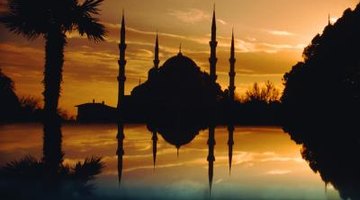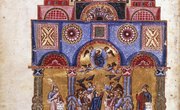The Byzantine Empire was a predominantly Greek-speaking continuation of the Roman Empire that emerged in around 330 as Rome's decline began, existing in some form until the occupation of the Ottoman Turks in the 1400s. The capital city was originally called Byzantium, later known as Constantinople. Today it is the Turkish capital Istanbul. The Byzantines shared many cultural traditions with the Romans. However, as geographically distant from the original strongholds of the Romans, the Byzantine Empire developed its own culture marked by an advanced economy, advances in medicine and law and a strong tradition of art and literature.
An Advanced Economy
For many centuries, the Byzantine economy was among the most advanced in all of Europe and the Mediterranean. As a prime trading location, Constantinople thrived by buying and selling goods with many parts of Europe, Asia and North Africa. Silk was a major export and this helped keep the empire's economy well ahead of the declining conditions in the Roman Empire. However, the Crusades would later diminish the economy and increased taxation to support these missions have been pinpointed as one reason for the empire's eventual decline.
Professional Practices
Byzantines were highly regarded as leaders in the development of philosophy, metaphysics and early medicine. Until the sixth century, professionals working in the Byzantine Empire made many notable achievements in scientific applications, including in architecture and the use of early surgical methods. However, after the sixth century and during that century's plague across the empire, scholarship slowed. A renaissance occurred by around 950 and medical and legal professionals were once again on the rise. Specifically, the Byzantine Empire is credited with logging the history and legal traditions of Arabic and Persian peoples and with developing theories in astronomy and mathematics.
Monotheistic Religious Polity
Byzantines were generally monotheistic and believed in the divine right of the Emperor. The Emperor had large control over the affairs of the official church. In later years, the Byzantines came to see the Emperor as the representative of Christ on earth. A motto of "One God, One Empire, One Religion" was often expounded as official state policy.
Artistic and Literary Expression
Byzantine art, most notably the images of saints, the Christ child and the Virgin Mary depicted in small, gold-leaf decorated frames, reflects primarily religious iconography. The frescos and paintings produced during much of the empire's history is conventional and seeks to translate church theology into artistic expression. The literature, however, was more secular and would often emphasis Greek, Roman and even Eastern philosophies. Poetry was heavily produced, although much of it was ecclesiastical in nature.
Related Articles
References
Writer Bio
Jeremy Bradley works in the fields of educational consultancy and business administration. He holds a Master of Business Administration degree.











